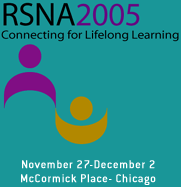
Abstract Archives of the RSNA, 2005
Agnieszka Trojanowska MD,PhD, Presenter: Nothing to Disclose
Andrzej Drop PhD, Abstract Co-Author: Nothing to Disclose
Tomasz Jargiello, Abstract Co-Author: Nothing to Disclose
Elzbieta Czekajska Chehab MD, PhD, Abstract Co-Author: Nothing to Disclose
Joanna Wojczal, Abstract Co-Author: Nothing to Disclose
We sought to determine changes in cerebral perfusion parameters, based on CT perfusion imaging, in patients who have severly stenotic (>70% according to NASCET criteria) internal carotid artery. undergone We also investigated, whether in these patients unilateral transluminal angioplasty and stent placement can establish a long - term improvement in cerebral hemodynamics.
Seventy four patients with symptomatic high – grade internal carotid artery stenosis were studied with CT perfusion imaging before and – on average – 70 hours and 172 days after carotid stent placement. Patients were initially assessed with carotid duplex ultrasound. CT examination was performed using helical CT scanner (Light Speed Ultra Advantage, GE Medical Systems) with the following protocol: non-contrast enhanced transaxial CT of the brain and dynamic CT perfusion imaging during administration of 50 ml of contrast medium (4 ml/s, delay 5 s, duration 50 s). Maps showing the absolute values of cerebral blood flow (CBF), cerebral blood volume (CBV) and mean transit time (MTT) were generated by deconvolution of the tissue enhancement curves from 2x2 pixel blocks of th brain with an intracranial artery's contrast enhancement curve. During interventional procedure carotid SILVER stent (Cook) was used. All patients underwent stent insertion with the use of neuroprotection devices (filters). In each patient precise neurological examination was performed by a stroke neurologist.
Perfusion deficits were present in 84% of patients with carotid artery stenosis, ipsilaterally to stenotic site. A marked MTT elongation was noted (6.2 – 6.8 s) together with decreased values of CBF (40 – 46 ml/100g/min) and slightly increased CBV (3.2 ml/100g). In this group, 3 days after carotid artery stenting, 30% of patients had perfusion deficits, and after 6 months it diminished to 6%.
In all patients stent placement was technically succesfull. The overall complication rate (any stroke or death) was 1.4%.
There is inadequate compensation of unilateral stenosis in terms of brain perfusion. Hypoperfusion tends to improve considerably after carotid artery stenting.
We sought to determine changes in cerebral perfusion parameters, based on CT perfusion imaging, in patients who have severly stenotic (>70% according to NASCET criteria) internal carotid artery. undergone We also investigated, whether in these patients unilateral transluminal angioplasty and stent placement can establish a long - term improvement in cerebral hemodynamics.
Seventy four patients with symptomatic high – grade internal carotid artery stenosis were studied with CT perfusion imaging before and – on average – 70 hours and 172 days after carotid stent placement. Patients were initially assessed with carotid duplex ultrasound. CT examination was performed using helical CT scanner (Light Speed Ultra Advantage, GE Medical Systems) with the following protocol: non-contrast enhanced transaxial CT of the brain and dynamic CT perfusion imaging during administration of 50 ml of contrast medium (4 ml/s, delay 5 s, duration 50 s). Maps showing the absolute values of cerebral blood flow (CBF), cerebral blood volume (CBV) and mean transit time (MTT) were generated by deconvolution of the tissue enhancement curves from 2x2 pixel blocks of th brain with an intracranial artery's contrast enhancement curve. During interventional procedure carotid SILVER stent (Cook) was used. All patients underwent stent insertion with the use of neuroprotection devices (filters). In each patient precise neurological examination was performed by a stroke neurologist.
Perfusion deficits were present in 84% of patients with carotid artery stenosis, ipsilaterally to stenotic site. A marked MTT elongation was noted (6.2 – 6.8 s) together with decreased values of CBF (40 – 46 ml/100g/min) and slightly increased CBV (3.2 ml/100g). In this group, 3 days after carotid artery stenting, 30% of patients had perfusion deficits, and after 6 months it diminished to 6%.
In all patients stent placement was technically succesfull. The overall complication rate (any stroke or death) was 1.4%.
There is inadequate compensation of unilateral stenosis in terms of brain perfusion. Hypoperfusion tends to improve considerably after carotid artery stenting.
Trojanowska, A,
Drop, A,
Jargiello, T,
Czekajska Chehab, E,
Wojczal, J,
Cerebral Hemodynamics in Carotid Artery Stenosis: Evaluation with CT Perfusion Studies. Radiological Society of North America 2005 Scientific Assembly and Annual Meeting, November 27 - December 2, 2005 ,Chicago IL.
http://archive.rsna.org/2005/4416352.html

